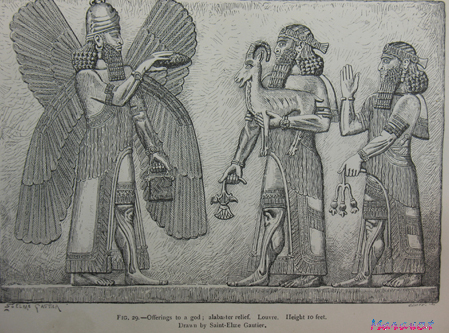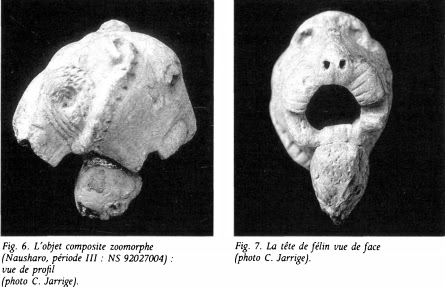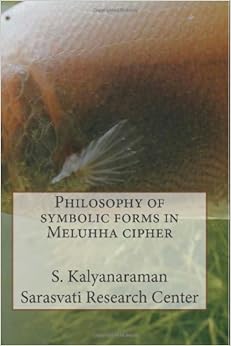
 Raphia farinifera mangrove palm-bush and fruits. A very spectacular palm, with a trunk to about 10 m. The leaves up to 20 m long, (amongst the largest in the plant kingdom), point almost upright. The stems are monocarpic.
Raphia farinifera mangrove palm-bush and fruits. A very spectacular palm, with a trunk to about 10 m. The leaves up to 20 m long, (amongst the largest in the plant kingdom), point almost upright. The stems are monocarpic.
Raphia farinifera
1, habit; 2, mid-section of leaf; 3, leaf apex; 4, inflorescence branch; 5, female flower; 6, male flower (one petal removed); 7, infructescence branch; 8, fruit.
Raphia farinifera habitat: The edges of rivers and lakes distributed throughout the southern part of tropical Africa. It is frequently cultivated, for instance in Nigeria, Madagascar, the Seychelles, Réunion, India, the United States and the Lesser Antilles. Vernacular names: nakl al shaytan (Arab.), Bambuspalme (G.), Raffiabastpalme (G.), Raffiaweinpalme (G.), mavale (Kenya), mvale (E Africa), mwaale (Kenya), mwalo (E Africa).
PROSEA http://www.prota4u.org/protav8.asp?p=Raphia+farinifera
Ht. 10 feet.Alabaster relief in the Louvre. Drawing by Saint-Elme Gautier. Illustration for A History of Art in Chaldaea and Assyria by Georges Perrot and Charles Chipiez (Chapman and Hall, 1884) The winged person, whose helmet has three sets of horns holds a raphia farinifera cone on his right palm. The person (perhaps a Meluhha) with antelope on his left arm appears to be holding a date cluster on his right hand; he is followed by a person holding a pomegrante cluster.
I suggest that very specific Meluhha hieroglyphs are deployed on the alabaster relief in Louvre Museum showing a trade encounter of Ashur merchant (the winged, horned person) with Meluhha merchant and his asistant.
mlekh'goat' carried by him denotes the Meluhha merchant (dealing in) milakkhu'copper'. The twig or sprig on his right hand: ḍhāḷā m. ʻsprig' meṛh'mrchant's assistant' carries a cluster of pomegranates: ḍ̠āṛhū̃ 'pomegranate' (Sindhi) Rebus: ḍhālako 'a large metal ingot' (Gujarati)
ḍāla
2. WPah.jaun. dāṛim, Ku. dā̆ṛim, dālim, dālimo, N. dārim, A. ḍālim, B. dāṛim, dālim, Or. dāḷimba, °ima, dāṛima, ḍāḷimba,ḍarami ʻ tree and fruit ʼ; Mth. dāṛim ʻ pomegranate ʼ, daṛimī ʻ dried mango ʼ; H. dāṛimb, °im, dālim, ḍāṛim, ḍār°, ḍāl° m., M.dāḷĩb, °ḷīm, ḍāḷĩb n. ʻ the fruit ʼ, f. ʻ the tree ʼ.3. Sh.gil. daṇū m. ʻ pomegranate ʼ, daṇúi f. ʻ the tree ʼ, jij. ḍ
Rebus: ḍhālako = a large metal ingot (G.) ḍhālakī = a metal heated and poured into a mould; a solid piece of metal; an ingot (Gujarati)
Louvre Museum. Fragment of a large cylinder seal;top:bull,center a draped figure (Goddess Inanna?) offering a libation. H:6 cm AO 6620
Louvre Museum. Mold in the form of a fish. Such molds were used for baked dishes for the royal table. Period of the Amorite dynasties, early 2nd mill.BCE Terracotta, 29,3 x 12 cm AO 18915
Louvre Museum. Two zoomorphous genii holding the sacred palm tree. From Eshnunna (Tell Asmar near Baghdad,Iraq). Early 2nd mill.BCE Baked clay tablet, 9,6 x 7 cm AO 12446
Cylinder seal of the priest-king Uruk period, circa 3200 BC Iraq, findspot unknown. Louvre Museum. This provides a clear delineation of the 'cone-shaped' fruit in the context of date-palm fond carried on the lady's hands assuring the possibility that the artist who made the seal is attempting to depict raphia farinifera cone.
![]() Cylinder seal and imprint: bulls raised against trees, a symbol of abundance. Kassite period, 1595-1200 BCE Limestone, H: 5,5 cm, 1,7 across. AO 25365
Cylinder seal and imprint: bulls raised against trees, a symbol of abundance. Kassite period, 1595-1200 BCE Limestone, H: 5,5 cm, 1,7 across. AO 25365
![]() Cylinder seal and imprint, period of the Assyrian merchant settlements in Cappadocia, 19th-18th BCE Sacrifice of a kid to Shamash the sun-god,identified by the mountain from wich he escapes and the saw-like dagger. Haematite, H: 2,5 cm MNB 1171 Louvre Museum.
Cylinder seal and imprint, period of the Assyrian merchant settlements in Cappadocia, 19th-18th BCE Sacrifice of a kid to Shamash the sun-god,identified by the mountain from wich he escapes and the saw-like dagger. Haematite, H: 2,5 cm MNB 1171 Louvre Museum.
![]() Louvre Museum. Tip of a lance with image of a lion; the inscription says "Ur-lugal, King of Kish". From Tello (Lagash) Period of Archaic Dynasties, 2500-2340 BCE Bronze, H: 85 cm AO 2675
Louvre Museum. Tip of a lance with image of a lion; the inscription says "Ur-lugal, King of Kish". From Tello (Lagash) Period of Archaic Dynasties, 2500-2340 BCE Bronze, H: 85 cm AO 2675
![]() Louvre Museum. Cylinder seal and imprint, Assyrian. Two figures around an altar; above the altar a solar disk with wings; a god on a bull. Agate, H: 3 cm AO 22347
Louvre Museum. Cylinder seal and imprint, Assyrian. Two figures around an altar; above the altar a solar disk with wings; a god on a bull. Agate, H: 3 cm AO 22347
![]() Louvre Museum. Stele with eagle;inscription on the plinth:"Made by Zabd'Abel,son of Zebda Baida".From Palmyra,ancient Tadmor,Syria. Limestone relief
Louvre Museum. Stele with eagle;inscription on the plinth:"Made by Zabd'Abel,son of Zebda Baida".From Palmyra,ancient Tadmor,Syria. Limestone relief
 Cylinder seal and imprint: bulls raised against trees, a symbol of abundance. Kassite period, 1595-1200 BCE Limestone, H: 5,5 cm, 1,7 across. AO 25365
Cylinder seal and imprint: bulls raised against trees, a symbol of abundance. Kassite period, 1595-1200 BCE Limestone, H: 5,5 cm, 1,7 across. AO 25365 Stele of Si' gabbor, priest of the moon-god, sitting in front of a table with offerings. Aramaic inscription. Early 7th BCE, from Neirab,Syria Basalt bas-relief, H: 95 cm AO 3027 . Louvre Museum. The legs of the stool and seated chair are decorated with 'cone' hieroglyphs. Maybe, the hieroglyph kept on the bowl atop the stool is also a 'cone' artifact. The standing person is perhaps holding a date-palm cluster.
 Cylinder seal and imprint, period of the Assyrian merchant settlements in Cappadocia, 19th-18th BCE Sacrifice of a kid to Shamash the sun-god,identified by the mountain from wich he escapes and the saw-like dagger. Haematite, H: 2,5 cm MNB 1171 Louvre Museum.
Cylinder seal and imprint, period of the Assyrian merchant settlements in Cappadocia, 19th-18th BCE Sacrifice of a kid to Shamash the sun-god,identified by the mountain from wich he escapes and the saw-like dagger. Haematite, H: 2,5 cm MNB 1171 Louvre Museum.Two snakes and five small divine figures holding vases. Bronze sacrificial altar cast in one piece. Middle-Elamite era (10th-9th BCE), from Susa, Iran 158 x 70.5 cm - Sb 185
Louvre Museum. Genius with two pairs of wings. In a gesture of magic protection, he holds a cedar cone in one hand, a bucket in the other. From Nimrud, capital of king Ashurnarzipal II (883-859 BCE).. Gypseous alabaster, H: 228 cm AO 19845
 Louvre Museum. Tip of a lance with image of a lion; the inscription says "Ur-lugal, King of Kish". From Tello (Lagash) Period of Archaic Dynasties, 2500-2340 BCE Bronze, H: 85 cm AO 2675
Louvre Museum. Tip of a lance with image of a lion; the inscription says "Ur-lugal, King of Kish". From Tello (Lagash) Period of Archaic Dynasties, 2500-2340 BCE Bronze, H: 85 cm AO 2675 Louvre Museum. Two worshippers, one carrying a kid, the other a small animal. From the acropolis of Susa, middle-Elamite, period of the Shutrukides dynasty, 13th BCE. Silver and gold, H: 7,5 and 7,6 cm Sb 2758, 2759
Louvre Museum. Bronze tripod hung with pomegranates - a symbol of fertility reminiscent of the decorations of the Solomonic temple in Jerusalem. From Ugarit,Syria. Late Bronze H: 12 cm, 14,3 cm across AO 11606
 Louvre Museum. Cylinder seal and imprint, Assyrian. Two figures around an altar; above the altar a solar disk with wings; a god on a bull. Agate, H: 3 cm AO 22347
Louvre Museum. Cylinder seal and imprint, Assyrian. Two figures around an altar; above the altar a solar disk with wings; a god on a bull. Agate, H: 3 cm AO 22347  Louvre Museum. Stele with eagle;inscription on the plinth:"Made by Zabd'Abel,son of Zebda Baida".From Palmyra,ancient Tadmor,Syria. Limestone relief
Louvre Museum. Stele with eagle;inscription on the plinth:"Made by Zabd'Abel,son of Zebda Baida".From Palmyra,ancient Tadmor,Syria. Limestone relief Louvre Museum. Worshipper with a pigeon? (Maybe, karaḍa ,' an aquatic bird' to describe the nature of hard alloye used for the bronze casting). Bronze statuette (late 2nd millenium BCE) from Susa, Iran 11 x 3.8 cm Sb 2889
Goblet,electrum,decorated with fabulous animals with entwined feet,two kids.From Marlik, northern Iran. Iron Age I. Reverse side. For front and bottom view see 08-02-16/6,8 AO 20281

A palm fond is also shown on a Dagger Chape of ca. 539-333 BCE. A lion bites into an ibex (long neck and head seen). Bone. H. 30 cm; W. 45 cm; D. 10 cm. Antoine-Barthélémy Clot Bey collection N 8336 (MN 1376).
 Blessing genius Bone
Blessing genius BoneNeo-Assyrian period, circa 721-705 BC (reign of Sargon II) Third gate of the palace of Sargon II, Khorsabad (ancient Dur-Sharrukin), Iraq Louvre Museum
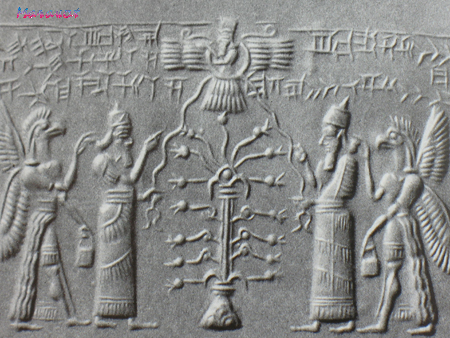
 Date-clusters on date-palm.
Date-clusters on date-palm.| Cylinder seal with the solar disk of Ashur, anointing with two eagle-headed gods before the Tree of Life. The blossoms on the tree appear to be pomegranates. |
 Description: Cylinder seal and modern impression- bull-men flanking deity above sacred tree, and a winged deity holding horned animal heads.
Description: Cylinder seal and modern impression- bull-men flanking deity above sacred tree, and a winged deity holding horned animal heads.Date: c.8th-7th century BCE
Location: Metropolitan Museum of Art, New York
 Balawat Bronze Gate Band of Assurnasirpal II: http://www.arthistory.upenn.edu/spr03/422/April24/16.JPG
Balawat Bronze Gate Band of Assurnasirpal II: http://www.arthistory.upenn.edu/spr03/422/April24/16.JPGArecaceae (Palmae), Raphia farinifera, Mwaale (Swahili) » Raffia seed Fruit de raphia farinifera
Rebus: śitá ʻ whetted, sharp ʼ RV. [√

Apple Annona squamosa.Sugar Apples or Sweetsop, is native to the tropical Americas, but is also widely grown in Pakistan, India and the Philippines. The fruit looks a bit like a pine cone, and are about 10 cm in diameter. Under the hard, lumpy skin is the fragrant, whitish flesh of the fruit, which covers several seeds inside, and has a slight taste of custard. It is called sītaphal, 'sīta fruit' in South India.
 Eagle-headed protective spirit between sacred trees.Assyrian, ca. 865-860 BCE from Nimrud, North-west Palace, Room F, Panel 8 http://encyclopediaurantia.org/treeoflife.htm
Eagle-headed protective spirit between sacred trees.Assyrian, ca. 865-860 BCE from Nimrud, North-west Palace, Room F, Panel 8 http://encyclopediaurantia.org/treeoflife.htm *siḍha ʻ sail ʼ. [Cf. śīta -- 2 n. ʻ sail ʼ BHSk., Pa. sīta -- n.] Pk. saḍha -- m. ʻ sail ʼ Deśīn., S. siṛhu m., L. siṛh m., G. saḍh m., M. śīḍ n.(CDIAL 13397).
*siṭṭa ʻ ear of corn, straw (?) ʼ. S. siṭo m. ʻ ear of corn ʼ, L. P. siṭṭā m.; -- N. siṭo, siṭho ʻ dry twig ʼ?(CDIAL 13396).
sīˊtā f. ʻ furrow, goddess of agriculture ʼ RV. Pa. sītā -- f. ʻ furrow ʼ, Pk. sīā -- f., Sh. (Lor.) sī; L. sī˜, sīã f., sīvī˜ f., sīyã̄ m. ʻ a ploughing ʼ, awāṇ. sī˜ ʻ cultivation ʼ; P. sī˜ f. ʻ furrow, ploughing ʼ, ludh. sī f.; WPah. bhal. sihā f. ʻ furrow ʼ, sī f. ʻ the second ploughing ʼ, jaun. sī˜ ʻ furrow ʼ; Ku. siyo ʻ a ploughing ʼ, gng. śyu ʻ furrow ʼ, N. siyo; Si. sī, hī, hīya ʻ furrow, ploughing ʼ;P. siāṛ m. ʻ furrow ʼ, WPah. khaś. se\ āṛ (+?). -- Pk.sīā<-> f. ʻ Sītā ʼ, OAw. siya. WPah.kṭg. sīˊ f. (obl. -- a) ʻ furrow ʼ; Sía ʻ Sītā ʼ (retention of -- a due to lw. Sītā Him.I 214).(CDIAL 13428).
Or. siṭha ʻofficer of a rājā's household in charge of palace and granaryʼ; śiṣṭá2 ʻ taught ʼ AV., ʻ disciplined ʼ ŚBr., ʻ learned ʼ Mn., m. ʻ chief ʼ Hit. [√śās ] Pk. siṭṭha -- ʻ ordered, taught ʼ, m. ʻ gentleman ʼ; NiDoc. śiṭha ʻ punishment ʼ, śiṭhidavya ʻ to be punished ʼ; N. siṭnu ʻ to reprimand ʼ; Si. siṭu ʻ nobleman ʼ, hiṭāno ʻ very wealthy man ʼ (ES 96 < śrēṣṭhin -- ).(CDIAL 12479). సెట్టి [ seṭṭi ] or శెట్టి seṭṭi. [from Skt. శ్రేష్ఠీ .] n. A merchant, వర్తకుడు . A title assumed by all members of the Bēri Komati, or Balija caste who are merchants. బేరి bēri. n. A man of the Beri or merchant caste. బేరము (p. 0906) [ bēramu ] bēramu. [Tel.] n. Trade, dealing, a bargain, బేరముసారము or బేర సారము trade, &c. (సారము being a mere expletive.) బేరకాడు bēra-kāḍu. n. One who makes a bargain, a purchaser, buyer. (Telugu)செட்டி¹ ceṭṭi , n. < Pkt. sēṭṭišrēṣṭhin. [M. ceṭṭi.] 1. Vaišya or mercantile caste; வைசியன். முட்டில் வாழ்க்கைச் செட்டியார் பெருமகன் (பெருங். இலாவாண. 20, 126). 2. Title of traders; வியாபாரிகளின் பட்டப்பெயர். 3. Skanda; முருகன். கடற்சூர் தடிந்திட்ட செட்டி (தேவா. 742, 10). செட்டிமை ceṭṭimai , n. < id. 1. Quali- ties, characteristics of the Chetti caste; செட்டித் தன்மை. (யாழ். அக.) 2. Trade, traffic, mercantile profession; வியாபாரம். (W .) செட்டு ceṭṭu , n. < செட்டி¹ cf. šrēṣṭhi-tā. [M. ceṭṭu.] 1. Trade, traffic; வியாபாரம். (யாழ். அக.) kirāṭa m. ʻ merchant ʼ Rājat., kirīṭa -- 2 m. BhP., kírāta- m. ʻ a degraded mountain tribe ʼ VS., cilātī -- f. ʻ woman of this tribe ʼ YogH. [Alternance of k -- and c -- , -- ṭ -- and -- t<-> suggests Drav. origin, EWA i 211. Perh. same as kilāta -- ʻ dwarf ʼ] Pa. kirāṭa -- m. ʻ fraudulent merchant ʼ (kirāṭa -- , °āta<-> m. ʻ man of a jungle tribe ʼ see kilāta -- ); Pk. kirāḍa -- , °āya -- , cilāa -- m., f. °āī -- ,°āiyā -- ʻ a non -- Aryan tribe, slave ʼ, cilāī -- f.; S. kirāṛu m. ʻ Hindu shopkeeper ʼ; L. kirāṛ, karāṛ m., kirāṛī f. ʻ member of a tribe of Hindus (also called aroṛā) who act as traders and moneylenders ʼ; H. kirāṛ m. ʻ merchant ʼ. -- Deriv. Pa. kērāṭika -- , °iya<-> ʻ false ʼ (cf. kirāsa -- ʻ fraudulent ʼ); -- L. kirṛakkā ʻ connected with Hindus ʼ.(CDIAL 3173).
செட்டை¹ ceṭṭai , n. < T. ceṭṭupa. 1. Wing, feather, plumage; சிறகு. (யாழ். அக.) 2. Fin; மீன்சிறை. (W .) చెట్టువ cheṭṭupa. n. A wing. రెక్క.(Telugu) Ta. ceṭṭai wing, feather, plumage, fin, shoulderblade. Te. ceṭṭupa, caṭṭupa wing.(DEDR 2764). Kol. saṭṭa shoulder-blade, (SR.) shoulder. Nk. saṭṭa back. Go. (W. Ph.) saṭṭā, (Tr.) sattā, (G. Mu. S.) haṭṭa, (M. Ma.) aṭṭa, (Ko.) aṭa jaba shoulder (Voc. 3326); (ASu.) seṭṭā shoulder-blade. ? Ma. caṭṭuvam shoulder-bone (or with 2309 Ta. caṭṭukam). (DEDR 2303)
కండె [ kaṇḍe ] kaṇḍe. [Tel.] n. A head or ear of millet or maize. జొన్నకంకి .
Rebus: kaṭhiná ʻ hard, stiff ʼ Suśr. [EWA i 144 with lit. groups kaṭhiná -- , káṭhōra -- , °ōla -- , kaṭhara -- , kaḍḍati as ← Drav. Tam. kaṭṭu ʻ hardness ʼ, Tu. gaṭṭi, &c.]Pa. kaṭhina -- ʻ hard, stiff, cruel ʼ; Pk. kaḍhiṇa -- , °aga -- , kaṭṭhiṇa -- ʻ hard ʼ; M. kaḍhīṇ ʻ difficult ʼ, khaḍīṇ, °ḍaṇ ʻ vicious, difficult (of an animal) ʼGarh. kaṛe ʻ hardness ʼ(CDIAL 2650). खरा kharā Genuine, real, not counterfeit. Good, undebased, unalloyed--coins, the precious metals. करडा [ karaḍā ] Hard from alloy--iron, silver &c.(Marathi)Ta. kaṭṭu (kaṭṭi-) to harden, consolidate, congeal, coagulate, be congested (as the throat), swell (as a boil, tumour); n. boil, abscess, tumour; firmness, strength; kaṭṭu-kkāval strict guard; kaṭṭi clod, lump, concretion, anything hardened, coagulated, boil, abscess, tumour, enlarged spleen, foetus;keṭṭi firmness, hardness, strength; (-pp-, -tt-) to harden, strengthen, make firm; keṇṭai, keṇṭai-kkaṭṭi enlargement of the spleen. Ma. kaṭṭa lump, mass, clod; kaṭṭi what is condensed, solid, ingot; kaṇṭi lump, concretion; keṇṭa a hypochondriacal disease. Ko. kaṭy solid lump; kaṭ-ka·vl close watch; kaṛcvery hard, brittle steel; kaṛg gristle; geṇḍ round lump or ball (food, butter), growth in abdomen; geṇḍ-payṇ frost on grass, ice on top of water. To. koṭ- (koṭy-) (blister) to form, swell. Ka. kaṭṭu to gather (as a boil, secretion, or lump); kaḍugu to become hard or solid; gaṭṭi firmness, hardness, lump; gaḍacu, gaḍasu, gaḍusu hardness, brittleness, severity; gaḍḍe, gaṇṭe a mass, ump, concretion; island. Koḍ. kaṭṭi mo·rï curd (cf. 4902 Ta. mucar); (Shanmugam) gëṭṭi hard; gëṇḍe spleen. Tu. gaṭṭi, gaḍůsů firm, hard; gaṭṭè, geṭṭi, geṭṭè a lump, clod. Te. kaṭṭu to gather, collect, become hard; gaṭṭi, gaḍusu hard, firm; gaḍḍu hard, difficult; gaḍḍa lump, mass, clod, clot; boil, ulcer; island; (for -gaḍa/-gaḍi clod, cf. 820). Kol. (Pat., p. 107) gaṭṭi thick (density); keḍk hard. Nk. kaṭṭ spleen. Pa. (S.) kay-gaṭṭa bile (cf. 1249). Ga. (S.3 )gaṭṭin hard. Go. (Tr. Mu.) kaṭ spleen; (Ma.) kaṭṭi gall-bladder (Voc. 464); (Ko.) kay-kaṭ bile (Voc. 523); (Ma.) kaṭṭ- (fruits) to form (Voc. 471); (Ko.) gaṭṭi very (Voc. 1022); (Ko.) gaṭ pāpe Adam's apple (Voc. 1023; pāpe throat); gaḍa clod (Voc. 1024). Kui ḍṛahpa (ḍṛaht-) to be hard, stiff, difficult, troublesome; n. hardness, stiffness, difficulty, trouble; ḍrai hard, stiff, firm; ḍrai inba to be hard, etc.; ḍrāna solidly. Kuwi (F.) gatteninga strongly, loudly; (S.) gatti hard; adv. gattininga. ? Kur. kaṛarnā (kaṛryas), kaḍrnā to congeal, freeze, be paralysed with fear. ? Cf. 1144 Ta. keṭṭi. / Cf. Turner, CDIAL, no. 2650, kaṭhina- hard, firm, stiff; no. 2651, kaṭhara-, kaṭhura-, káṭhora- hard; no. 2657, kaḍḍ- to be hard, severe (DhP.).(DEDR 1148).
British Museum. ME 89115
Greenstone seal of scribe Adda. The winged lady holding a cluster of dates. Shows Enki depicted with a flowing stream full of fish;c.2300-2200 BCE. Enki's two-faced minister Isimu stands to his right. Adda is the name of a storm-god with a temple in Aleppo.
Four of the principal Mesopotamian deities
This is one of the many high quality greenstone seals that were made when much of Mesopotamia was united under the military control of the kings of the city of Agade (Akkad). The cuneiform inscription identifies the owner of the seal as Adda, who is described as dubsar, or 'scribe'.
The figures can be identified as gods by their pointed hats with multiple horns. The figure with streams of water and fish flowing from his shoulders is Ea (Sumerian Enki), god of subterranean waters and of wisdom. Behind him stands Usimu, his two-faced vizier (chief minister).
At the centre of the scene is the sun-god, Shamash (Sumerian Utu), with rays rising from his shoulders. He is cutting his way through the mountains in order to rise at dawn.
To his left is a winged goddess, Ishtar (Sumerian Inanna). The weapons rising from her shoulders symbolise her warlike characteristics; she also holds a cluster of dates.
The god armed with a bow and quiver has not been identified with certainty, but may represent a hunting god like Nusku.
J.E. Reade, Mesopotamia (London, The British Museum Press, 1991)
D. Collon, First impressions: cylinder se (London, The British Museum Press, 1987)
D. Collon, Catalogue of the Western Asi-1 (London, 1982)
A 14th-century B.C. relief depicts a "fish-man" carrying a pinecone and bucket. Temple of Adda, storm-god in Aleppo.
A half-man, half-bird frieze from Aleppo dating to 900 B.C. (left) could have been a model for artists working 30 years later on the famous reliefs at the Assyrian city of Nimrud. (Courtesy Kay Kohlmeyer; age fotostock/SuperStock) http://archive.archaeology.org/0911/features/syria_aleppo_temple_storm_god_citadel.html
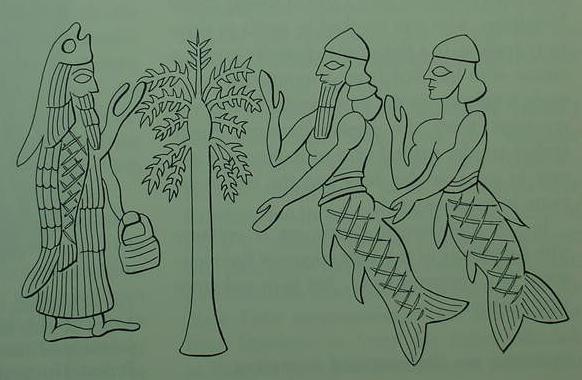
Neo-Assyrian bas reliefs show a sacred tree which appears to be highly stylized date palm enveloped by vine tendrils
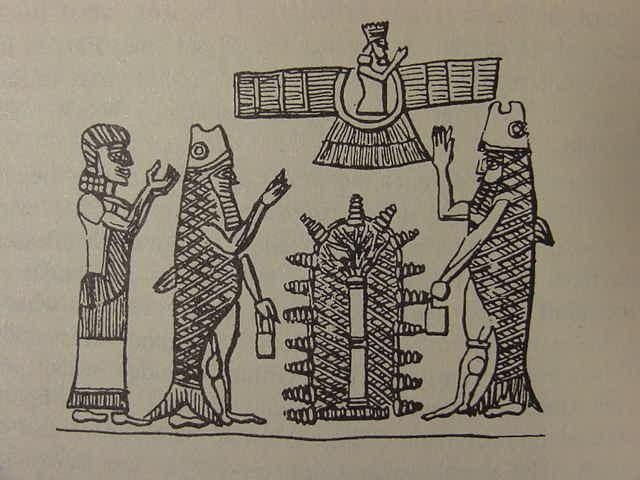 A cylinder seal showing "fishmen" holding pine cones (?) and pollen-buckets (?), adoring a sacred tree. Above the tree is the sun-god with eagle wings and tail (perhaps Utu, Shamash or Asshur?). This tree appears in other Neo-Assyrian art forms as a highly stylized Date-palm with a vine lattice and leaves, sometimes bearing fruits such as grapes (?). http://www.bibleorigins.net/AdapaAdamPicturesFishmen.html
A cylinder seal showing "fishmen" holding pine cones (?) and pollen-buckets (?), adoring a sacred tree. Above the tree is the sun-god with eagle wings and tail (perhaps Utu, Shamash or Asshur?). This tree appears in other Neo-Assyrian art forms as a highly stylized Date-palm with a vine lattice and leaves, sometimes bearing fruits such as grapes (?). http://www.bibleorigins.net/AdapaAdamPicturesFishmen.html 
PIne-cone on a relief of Ashur (Nimrud).
[quote] Detail of pine cone. Standard Inscription.Palace of Ashurnasirpal, priest of Ashur, favorite of Enlil and Ninurta, beloved of Anu and Dagan, the weapon of the great gods, the mighty king, king of the world, king of Assyria; son of Tukulti-Ninurta, the great king, the mighty king, king of Assyria, the son of Adad-nirari, the great king, the mighty king of Assyria; the valiant man, who acts with the support of Ashur, his lord, and has no equal among the princes of the four quarters of the world; the wonderful shepherd who is not afraid of battle; the great flood which none can oppose; the king who makes those who are not subject to him submissive; who has subjugated all mankind; the mighty warrior who treads on the neck of his enemies, tramples down all foes, and shatters the forces of the proud; the king who acts with the support of the great gods, and whose hand has conquered all lands, who has subjugated all the mountains and received their tribute, taking hostages and establishing his power over all countries.
When Ashur, the lord who called me by my name and has made my kingdom great, entrusted his merciless weapon to my lordly arms, I overthrew the widespread troops of the land of Lullume in battle. With the assistance of Shamash and Adad, the gods who help me, I thundered like Adad the destroyer over the troops of the Nairi lands, Habhi, Shubaru, and Nirib. I am the king who had brought into submission at his feet the lands from beyond the Tigris to Mount Lebanon and the Great Sea [the Mediterranean], the whole of the land of Laqe, the land of Suhi as far as Rapiqu, and whose hand has conquered from the source of the river Subnat to the land of Urartu.
The area from the mountain passes of Kirruri to the land of Gilzanu, from beyond the Lower Zab to the city of Til-Bari which is north of the land of Zaban, from the city of Til-sha-abtani to Til-sha-Zabdani, Hirimu and Harutu, fortresses of the land of Karduniash [Babylonia], I have restored to the borders of my land. From the mountain passes of Babite to the land of Hashmar I have counted the inhabitants as peoples of my land. Over the lands which I have subjugated I have appointed my governors, and they do obeisance.
I am Ashurnasirpal, the celebrated prince, who reveres the great gods, the fierce dragon, conqueror of the cities and mountains to their furthest extent, king of rulers who has tamed the stiff-necked peoples, who is crowned with splendor, who is not afraid of battle, the merciless champion who shakes resistance, the glorious king, the shepherd, the protection of the whole world, the king, the word of whose mouth destroys mountains and seas, who by his lordly attack has forced fierce and merciless kings from the rising to the setting sun to acknowledge one rule.
The former city of Kalhu [Nimrud], which Shalmaneser king of Assyria, a prince who preceded me, had built, that city had fallen into ruins and lay deserted. That city I built anew, I took the peoples whom my hand had conquered from the lands which I subjugated, from the land of Suhi, from the land of Laqe, from the city of Sirqu on the other side of the Euphrates, from the furthest extent of the land of Zamua, from Bit-Adini and the land of Hatte, and from Lubarna, king of the land of Patina, and made them settle there.
I removed the ancient mound and dug down to the water level. I sank the foundations 120 brick courses deep. A palace with halls of cedar, cypress, juniper, box-wood, meskannu-wood, terebinth and tamarisk, I founded as my royal residence for my lordly pleasure for ever.
Creatures of the mountains and seas I fashioned in white limestone and alabaster, and set them up at its gates. I adorned it, and made it glorious, and set ornamental knobs of bronze all around it. I fixed doors of cedar, cypress, juniper and meskannu-wood in its gates. I took in great quantities, and placed there, silver, gold, tin, bronze and iron, booty taken by my hands from the lands which I had conquered. [unquote]


Winged Eagle-Headed Being (Genie); Neo-Assyrian period, reign of Ashurnasirpal II (r. 883–859 B.C.), Mesopotamia; excavated at Nimrud (ancient Kalhu), Alabaster (gypsum) http://www.freerepublic.com/focus/f-chat/1836884/posts
 On this relief from Nimrud, a winged benevolent spirit blesses either the king or palace with a pine-cone.Walters Art Museum, Baltimore.
On this relief from Nimrud, a winged benevolent spirit blesses either the king or palace with a pine-cone.Walters Art Museum, Baltimore.
King Ashurnasirpal flanked by eagle-headed protective spirit, Assyrian ca 860 BC, Nimrud http://www.pbase.com/bmcmorrow/image/101156204
 Chaldean Assyrian relief sculpture slab from the northwest palace of King Ashurnasirpal II of a Genie standing. 881-859 B.C form Nimrud or Ni=mrut ( Kalhu or Kalah). Istanbul Archaeological exhibit Inv. No. 5. http://www.pinterest.com/magistramichaud/assyrians/
Chaldean Assyrian relief sculpture slab from the northwest palace of King Ashurnasirpal II of a Genie standing. 881-859 B.C form Nimrud or Ni=mrut ( Kalhu or Kalah). Istanbul Archaeological exhibit Inv. No. 5. http://www.pinterest.com/magistramichaud/assyrians/ 
harvested pine cones drying in the autumn sun Kozak

Kozak pine nuts in the raw
Assyrian Period, reign of King Ashurnasirpal 11 (883 -- 859 BCE) Alabastrous Limestone Height 110.5 cm. Width 183 cm. Depth 6.4 -- 9.6 cm. Miho Museum http://www.shumei.org/art/miho/miho.html
Hieroglyphs: kandə ʻpineʼ, ‘ear of maize’. Rebus: kaṇḍa ‘tools, pots and pans of metal’. Rebus: kāḍ ‘stone’. Ga. (Oll.) kanḍ, (S.) kanḍu (pl. kanḍkil) stone (DEDR 1298).
Hieroglyph: Ash. piċ -- kandə ʻ pine ʼ, Kt. pṳ̄ċi, piċi, Wg. puċ, püċ (pṳ̄ċ -- kəŕ ʻ pine -- cone ʼ), Pr. wyoċ, Shum. lyēwič (lyē -- ?).(CDIAL 8407). Cf. Gk. peu/kh f. ʻ pine ʼ, Lith. pušìs, OPruss. peuse NTS xiii 229. The suffix –kande in the lexeme: Ash. piċ-- kandə ʻ pine ʼ may be cognate with the bulbous glyphic related to a mangrove root: Koḍ. kaṇḍe root-stock from which small roots grow; ila·ti kaṇḍe sweet potato (ila·ti England). Tu. kaṇḍe, gaḍḍè a bulbous root; Ta. kaṇṭal mangrove, Rhizophora mucronata; dichotomous mangrove, Kandelia rheedii. Ma. kaṇṭa bulbous root as of lotus, plantain; point where branches and bunches grow out of the stem of a palm; kaṇṭal what is bulb-like, half-ripe jackfruit and other green fruits; R. candel. (DEDR 1171). Rebus: kaṇḍa ‘tools, pots and pans of metal’.
Hieroglyph: కండె [ kaṇḍe ] kaṇḍe. [Telugu] n. A head or ear of millet or maize. జొన్నకంకి.
खांदा [ khāndā ] An arm or a large bough of a tree; khānda खांद (Usually खांदी) A bough or branch (esp. a large one.) खांड [ khāṇḍa ] A chump or division of a tree.(Marathi)
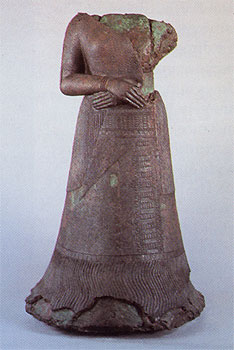
The statue was cast in two parts. A clay core allowed the making of a single shell of copper by the lost-wax technique. Once the core was removed, the shell was filled with soid bronze. Molded and engraved surface of Napir-Asu's garment was perhaps covered with gold and silver leaf. Head was never found and perhaps was cast separately. (Meyers, P., 2000, The casting process of the statue of Queen Napir-Asu in the Louvre, in: Mattusch, Carol C., Amy Brauer & Sandra E. Knudsen (eds.), JRA supplementary series no. 39.1 From the Parts to the whole, Vol. 1, ACTA of the 13th International Bronze Congress, held at Cambridge, Massachusetts, May 28-June 1, 1996.)
śiṣṭá2 ʻ taught ʼ AV., ʻ disciplined ʼ ŚBr., ʻ learned ʼ Mn., m. ʻ chief ʼ Hit. [√śās ] Pk. siṭṭha -- ʻ ordered, taught ʼ, m. ʻ gentleman ʼ; NiDoc. śiṭha ʻ punishment ʼ, śiṭhidavya ʻ to be punished ʼ; N. siṭnu ʻ to reprimand ʼ; Or. siṭha ʻ officer of a rājā's householdin charge of palace and granary ʼ; Si. siṭu ʻ nobleman ʼ, hiṭāno ʻ very wealthy man ʼ (ES 96 < śrēṣṭhin -- ).(CDIAL 12479).
The elephant head ligatured with a buffalo at Nausharo is a curtain-raiser for the practice of ligaturing in Indian tradition for utsava bera'idols carried on processions'. The phrase utsava bera denotes that processions of the type shown on Mesopotamian cylinder seals or Mohenjo-daro tablets are trade processions for bera'bargaining, trade'. Thus, the processions with hieroglyphs may be part of trade-exchange fairs of ancient times. It is significant that the utsava bera of Ganesa is shown together with a rat or mouse -- as vāhana: ibha 'elephant' Rebus: ib 'iron'. mūṣa'rat, mouse' Rebus: mūṣa'crucible'. Thus both rat/mouse and elephant face ligatured to a body, are Meluhha hieroglyphs related to metallurgical processes.
This note is a sequel to the work: Philosophy of symbolic forms in Meluhha cipher.
http://www.scribd.com/doc/218367721/Une-tete-d-elephant-en-terre-cuite-de-Nausharo-Pakistan-Catherine-Jarrige-lien-Arts-asiatiques-lien-Year-1992-lien-Volume-47-lien
The 51-inch Queen (without head) consists of a delicately patterned copper shell mounted on a bronze core. The sculpture, more than 3,000 years old, weighs 3,760 pounds and consists of a core of cast bronze containing 11% tin on which is mounted a copper shell cast in two halves neatly fitted together. The copper contains 1% tin plus traces of lead, iron, silver, nickel, bismuth and cobalt. The shell is attached to the core by means of copper drift pins.The Queen's husband, Untash-Napirisha, reigned over the Kingdom of Elam in the 14th Century, B.C. His capital, Susa (biblical Shushan) in what is now southwestern Iran, existed for 3,000 years. It was excavated by French archeologists early in this century. All 200 objects in the exhibition are on loan from the Louvre. http://www.copper.org/publications/newsletters/discover/1993/Ct74/bronze_statue.html
उच्-छिष्ट [p=174,1] n. leavings , fragments , remainder (especially of a sacrifice or of food) AV. S'Br.
"Thus it seems that the reconstruction of the word for ‘wax’ could equally well be *śiksta (as proposed by Paasonen) or *śista. In Indian sources, a formally and semantically perfect match can be found for Proto-Volga-Permic *śista ‘beeswax’, namely Sanskrit śistá- Ͻ Proto-Indo- Aryan *śistá-, preterite participle regularly formed with the suffix -tá- śrom the verbal root śis-‘to leave (over)’. In Ramayana 5.60.10. ‘beeswax’ is called madhu-śista-, literally ‘what is left over of honey’ and in some other texts synonymous terms madhucchista- and madhu-śesa-. śista- is used as a neuter noun meaning ‘remainder, remnant’ in Vedic texts (cf. śatapatha-Brahmana 11.5.4.18: interestingly, this passage speaks of eating honey). Sanskrit śista- has become sittha- ‘left over, remainder’ in Middle Indo-Aryan; its cognates in Modern Indo- Aryan languages usually mean ‘dregs’, but in Singhalese ‘wax’ (cś. Turner 1966: nos 12478 and 12480). There is an exact correspondence even between the Sanskrit compound madhu-śista- ‘beeswax’ and the Komi compound ma-siś ‘beeswax’, śor Komi ma corresponding to Udmurt mu goes back to Proto-Permic *mo and this to Proto- śinno-Ugric *mete ‘honey’, just as Komi va corresponding to Udmurt vu..."
http://www.slideshare.net/2sadanand/the-indoaryans (Parpola, Asko &Christian Carpelan, 2005, The cultural counterparts to proto-Indo-European, proto-Uralic and proto-Aryan: matching the dispersal and contact patterns in the linguistic and archaeological record, in: Bryant, Edwin W and Laurie L Patton, The Indo-Aryan controversy -- evidence and inference in Indian history, Routledge, p.117)
Technical description
Statue of Queen Napirasu, wife of Untash-Napirisha
C. 1340-1300 BC
Tell of the Acropolis, Susa
Bronze and copper
J. de Morgan excavations, 1903
Sb 2731This statue is of Queen Napirasu, wife of Untash-Napirisha, who ruled in the Middle Elamite period as one of the greatest Igihalkid kings. Under this dynasty, a great Elamite empire flourished, taking advantage of the decline of neighboring Mesopotamia. Untash-Napirisha founded the city of Al-Untash-Napirisha and filled it with monuments decorated with statues, which are remarkable proof of the standard of Elamite metalworking techniques.
A statue protected by the gods
Queen Napirasu, Untash-Napirisha's wife, is shown standing. The figure is life-size, but the head and the left arm are damaged. She is wearing a short-sleeved gown covered in the sort of embroidery usually found on such garments. She has four bracelets on her right wrist and a ring on her leftring finger. Although her hands are crossed on her stomach, she is not in the pose usually associated with worship. The inscription on the front of the skirt is in Elamite, reflecting the kingdom's linguistic identity. This inscription gives the queen's name and titles, invokes the protection of the gods, describes the ritual offerings made to them, and calls down their curse on anyone bold enough to desecrate her likeness. The statue is placed under the protection of the god Beltiya and three deities associated with the Igihalkid Dynasty - the god Inshushinak, the god Napirisha, and his consort Kiririsha. These three deities are also depicted on the stele of Untash-Napirisha, also in the Louvre (Sb3973).
Elaborate metalworking techniques
This statue of Queen Napirasu is a rare surviving likeness of a member of the royal court during the Middle Elamite period. The sheer amount of metal used - some 1,750 kg for a single work - reflects the wealth of the Elamite kingdom during Untash-Napirisha's reign. The dimensions and the finesse of the statue also reflect the skill of the Elamite metalworkers. The work must have been cast in two successive parts: a lost-wax cast for the copper and tin shell, followed by a full cast alloy of bronze and tin for the core, rather than the more usual refractory clay. The two parts are held together with pins and splints. The sides would have originally been covered with gold or silver.
A great king and a great builder
The reign of the Igihalkid king, Untash-Napirisha, witnessed the launch of a major construction program. The king ordered the restoration of a large number of temples and also built a new religious capital, Al-Untash-Napirisha (sometimes simply known as Al-Untash), on the site of modern-day Chogha Zanbil. The aim was to unite the different religions practiced in his kingdom in one place. Monuments throughout the city were decorated with numerous sculptures commissioned by the king, including this statue of his wife, which was discovered in Susa but was probably moved there from Al-Untash.
Bibliography
Amiet Pierre, Suse 6000 ans d'histoire, Paris, Éditions de la Réunion des musées nationaux, 1988, pp. 98-99 ; fig. 57.
Benoit A. , "Les Civilisations du Proche-Orient ancien", in Manuels de l'École du Louvre ; Art et archéologie, Paris, École du Louvre, 2003, pp 358-359 ; fig. 180.
Meyers Peter, "The casting process of the statue of queen Napir-Asu in the Louvre", extrait de : Journal of Roman Archaeology, supplementary series, n 39, Portsmouth, 2000, pp.11-18.
Benoit A. , "Les Civilisations du Proche-Orient ancien", in Manuels de l'École du Louvre ; Art et archéologie, Paris, École du Louvre, 2003, pp 358-359 ; fig. 180.
Meyers Peter, "The casting process of the statue of queen Napir-Asu in the Louvre", extrait de : Journal of Roman Archaeology, supplementary series, n 39, Portsmouth, 2000, pp.11-18.
Une tête d'éléphant en terre cuite de Nausharo (Pakistan)
In: Arts asiatiques. Tome 47, 1992. pp. 132-136. Jarrige Catherine
http://www.persee.fr/web/revues/home/prescript/article/arasi_0004-3958_1992_num_47_1_1330
The elephant head ligatured with a buffalo at Nausharo is a curtain-raiser for the practice of ligaturing in Indian tradition for utsava bera'idols carried on processions'. The phrase utsava bera denotes that processions of the type shown on Mesopotamian cylinder seals or Mohenjo-daro tablets are trade processions for bera'bargaining, trade'. Thus, the processions with hieroglyphs may be part of trade-exchange fairs of ancient times. It is significant that the utsava bera of Ganesa is shown together with a rat or mouse -- as vāhana: ibha 'elephant' Rebus: ib 'iron'. mūṣa'rat, mouse' Rebus: mūṣa'crucible'. Thus both rat/mouse and elephant face ligatured to a body, are Meluhha hieroglyphs related to metallurgical processes.
This note is a sequel to the work: Philosophy of symbolic forms in Meluhha cipher.
http://www.scribd.com/doc/218367721/Une-tete-d-elephant-en-terre-cuite-de-Nausharo-Pakistan-Catherine-Jarrige-lien-Arts-asiatiques-lien-Year-1992-lien-Volume-47-lien
